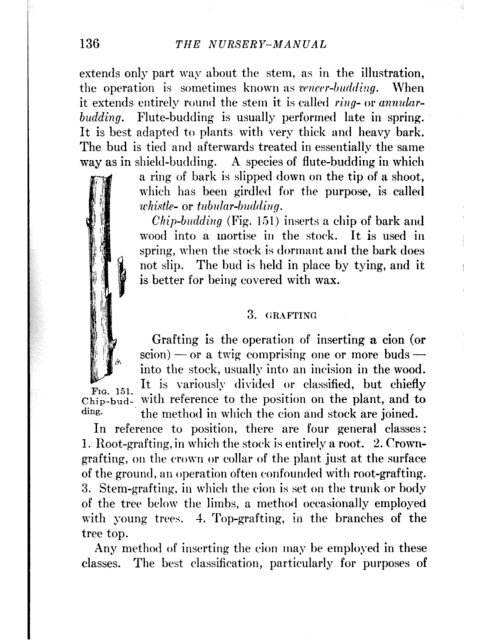- Page 1 and 2:
CHEREFERENCELIBRARYA project of Vol
- Page 4:
THEALBYL. PI. BAILEY
- Page 7 and 8:
.(‘11.4 PTERI. SEEDS ASD SHOOTS .
- Page 9 and 10:
hl iscrlla,ruWls forms of graftingS
- Page 11 and 12:
LISTOF PTAATES1.II I.III.IX.x.xi.x1
- Page 13 and 14:
CHAPTERISEEDS ANDSHOOTSTHE earth is
- Page 15 and 16:
SEEDS AND SHOOTS 3or accident befor
- Page 17 and 18:
Once a matter of home-growing and s
- Page 19 and 20:
SEEDS AXD SHOOTS 7the staple field
- Page 22:
10 THE NURSERY-.MANUi41,and carrot.
- Page 25 and 26:
12 THE NURSERY-MANUALhausted the st
- Page 27:
14 THE NURSERY-MANUALsown on the en
- Page 30 and 31:
PROPAG.4 TION BI’ MEANS OF SEEDS
- Page 32 and 33:
PROPAGATION BY MEANS OF' SEEDS AND
- Page 34 and 35:
PROPAG.4TlON BY MEANS OF SEEDS AND
- Page 36 and 37:
-_- . ..~._ _._67571067575144775515
- Page 38 and 39:
-PROP,4GATIOX BY MEANS OF SEEDS AND
- Page 41 and 42:
28 THE NURSERY-MANUALacross to perm
- Page 43 and 44:
30thermometer (d)ma.y b e placedto
- Page 45 and 46:
32 TH.E NCJRSERY-MANUA I,“ 111 t
- Page 47 and 48:
THENIJRSERY-MANU-4E
- Page 49 and 50:
36 THE NURSERY-MANK4Loperators. Som
- Page 51 and 52:
treated in this way. They are soake
- Page 53:
40 THE NURSERY-MANUALsort of strati
- Page 56 and 57:
PROPAGATION BY MEANS OF SEEDS AND S
- Page 59 and 60:
46 THE NURSERI’--MANUALOver the m
- Page 61:
48‘rrl’l~r rwepta(+5 in ?vltic4
- Page 64 and 65:
.. \;_ -: ..
- Page 66 and 67:
52 THE NURSERY-MANUALCross-section
- Page 68 and 69:
54 THE NURSERY-MANUALtrough. By var
- Page 70 and 71:
CIIAI’TEI~IIIPROPAGATION BY MFANS
- Page 72 and 73:
58 THE N URSERY-nil,4 N UA I,leek,
- Page 74 and 75:
60 THE h’ ITRSEIZ 1’- MA N ilA4
- Page 76 and 77:
5;62 THE NURSERY-MANUALfollowing se
- Page 78 and 79:
and represents but ;I single node ;
- Page 80 and 81:
66 THE NURSERY-MANUALas well as her
- Page 82 and 83:
68 THE NURSERY-MANlJALstock species
- Page 84 and 85:
’I(i. ,-)!b. Ru~~rwr of srclgc, c
- Page 86 and 87:
72 THE NURSERY-MANUALcase the cover
- Page 88 and 89:
74 ‘l’rrl!: NUIZSEIZY-k?~4N Q/A
- Page 90 and 91:
76 ‘r[II!: N (iR$ER Ii’--MA N i
- Page 93 and 94:
cliIws liids of air-hycrh g, varyin
- Page 95:
PLATE III. Prupngntion of hydrangea
- Page 98 and 99:
PROP.-1GATIOiV BY MEANS OF CUTTINGS
- Page 100 and 101:
.r.-,- ,+:,-- ‘- tic=e-.5c._-.
- Page 102 and 103: PXOP.-1GA TIOA;’ LiY MEANS OF CUT
- Page 104 and 105: PROl’,4Cr’A TlO,V BY MEANS OF C
- Page 107 and 108: 92 I’IIE NURSERY-MANUALquic~l+-.
- Page 109 and 110: 94 THE NURSER Y-MAN UA Iiparent bra
- Page 111 and 112: grape cuttings are sometimes pa&ed
- Page 113: ‘rlll)clrs arc tilidwtlcd pilrtS
- Page 116 and 117: can be made togrowfrom leafcutfings
- Page 119 and 120: There .~=e comparativelyfew species
- Page 122 and 123: porti:ms iif sterns art-I 011 recor
- Page 124 and 125: PROPAGATIO:~T BY iktEAN8 OF CUTTING
- Page 126 and 127: SUCll I~C’llt’i~iliIl~; ;I II u
- Page 129 and 130: CHAPTERVIPROPAGATION BY MEANS OF BU
- Page 131 and 132: PROPAGATION BY BUDDING AND GRAFTING
- Page 133 and 134: Z’Z~~~Il’~l~;.l TZO.2 Ii 1’ /
- Page 135 and 136: PRC)Y=1C.4TION BY BlJDDING AND GRAF
- Page 137 and 138: 1* employed on young fruit-trees, a
- Page 139 and 140: iuttlrfere with thtl opm~tiou. ‘l
- Page 141 and 142: LP'RQP~~G~~TIOLV BY BUDDING AND GRA
- Page 143 and 144: Thr~ but1 is now in-.serted in the
- Page 145 and 146: PROP;1I(I’ATION BY BUDDING AND GR
- Page 147 and 148: -L.-E,e.r-..A‘:- -t;;: siS%L- c%4
- Page 149 and 150: L’R(.lPrl(;A I’Ic,h’ Ii)’ H
- Page 151: .PROPAGATION BY BUDDING AND GRAFTIN
- Page 156: I“It;. 155. *(;r:lft; 011 :t ing
- Page 159 and 160: The lit.tle tongue of bark on the s
- Page 161 and 162: especially on large limbs, and its
- Page 163 and 164: I’ROI’AGd 7’ZoiY IC 1’ HiiD
- Page 165 and 166: % Y.r+-‘t L.7 -- I-=IY.-r:-=-- --
- Page 167 and 168: illust,ration of an old tree just t
- Page 169 and 170: 4-.i%’32h Icr
- Page 171 and 172: .PROPAGATION BY BUDDING AND GRAFI
- Page 173 and 174: : I.YS .YCz= Yc:F .H.5%3YcyP.c-l--.
- Page 175 and 176: The edges of the wound are trimmed,
- Page 177 and 178: PROPAGAT10N BY IZUDDING AND GRAFTIN
- Page 179 and 180: the books, is essentially this meth
- Page 181 and 182: parts are both atttached t,o their
- Page 184 and 185: Et&n ic~ttsltrd) . . . . . . . . .
- Page 186 and 187: CERTAIN ELEMENTS IN NURSERY PRACTIC
- Page 188 and 189: CrFRTAIN ELEMENTS IN NUIHERY PRACTI
- Page 190 and 191: _---._---c____I_-CERTdliV ELEi\IENT
- Page 192 and 193: CERTAl,V ELEMENTS IN NURSERY PRACTI
- Page 194 and 195: CERTAIN ELEMENTS IN NURSERY PRACTIC
- Page 196 and 197: %0 . ‘40? .l-b&5:..,’ c?1;5Y‘
- Page 198 and 199: CERTAIN ELEMENTS IN NURSERY PRACTIC
- Page 200 and 201: (,‘f;;‘fi’l’;t I:\’ E/,Ii
- Page 202:
(‘ERT.41.V ElI,E,lfENTS IN NURSER
- Page 205 and 206:
190 7’H-IR N IJRSER Y-M,4 N Ti.4
- Page 207:
192 THE NilJRSERY-MAN [JAI-,chinr.
- Page 210 and 211:
wF,r+-%’-.
- Page 212 and 213:
CERTAIN ELEMENTS IN NURSERY PRACTIC
- Page 214 and 215:
CERTAIN ELEMENTS IN NURSERY PRACTIC
- Page 217 and 218:
t:ERTAIN Ei,EMENTS IN NlrRSERY PRAC
- Page 219:
of iltl’t’t’t~V1 1)IlfIS fail
- Page 223 and 224:
Ihwli-swr 01~‘ I{oslr:s. - The di
- Page 226 and 227:
Often the aphids secrete a sweet li
- Page 228 and 229:
the spring. Dusting the foliage wit
- Page 230 and 231:
214 T?1E ,VliR,SERY-AIri NlJALTht W
- Page 233 and 234:
to I~loricl:~ ;llI(t t ‘illifr)l~
- Page 236:
THE NC~RSERY-LIST 221or fall. The c
- Page 239:
234 THE S CJRSERY-MAN r/ALAkhynanth
- Page 243:
x. . -( -7 -. w.2 -
- Page 247:
232 THE .hTIJR,SERY-~‘11,4,~‘UA
- Page 250 and 251:
THE NURSERY-LIS7’ 235selves are i
- Page 252 and 253:
T/II3 NURSER Y-LIST 237L>warf stock
- Page 254 and 255:
7’11 E ;Y I ~R:rS/(:R 1’ /,ILS7
- Page 256 and 257:
TTTE N URSERY-tTST 241tings are tak
- Page 258:
THE N TJRSER E’--LIST 243to give
- Page 261:
246 THE NURSERY-MANUALAuricula ( P~
- Page 264:
7’ II I!: N URSR R I’--- I, IST
- Page 268 and 269:
TIll.3 X URSERI--LIST 251Berberis (
- Page 271 and 272:
254 THE NURSERY-MANUALBlandfordia.
- Page 273 and 274:
Il’ittfvr wffiup. - Jlalcc the cu
- Page 275 and 276:
Bougainvillea. ;l’!lctcr~li~rctCc
- Page 278 and 279:
Buxus (Isos) . Ihrflcr cr.Propagatc
- Page 280 and 281:
THE NURSERY-LIST 263always more or
- Page 282 and 283:
THE NURSERY-LIST 265Calaciium. A rc
- Page 284 and 285:
-.7’lZE N URSER I’--LIST 267irl
- Page 286 and 287:
THli: NURSERY-LIST 2%may be used ;
- Page 288 and 289:
‘j%e stalks e;~n 1~ kept 01’er
- Page 290 and 291:
TfiE NURSERY-LIST 273Celtis (Nettle
- Page 292 and 293:
THE NURSERY-LIST’ 275quince, grow
- Page 294 and 295:
PLATE 1s. Two-yex budded cherry. on
- Page 296 and 297:
278 TIIE l~liR,S~~IR}‘--,ll.il:VI
- Page 298 and 299:
280 THE’ NURSERY-MANUALChorizema.
- Page 300 and 301:
232 THE N URSE R Y-MAN UALCineraria
- Page 302 and 303:
284 THE NURSERY-MANUALClianthus (Gl
- Page 304 and 305:
286 THE NURSERI’-Il~;lN~?rlLCodia
- Page 306 and 307:
288 THE NI~R~‘;E’RY-i12;1NIJrlI
- Page 308 and 309:
290 THE NURSERY-MANUALgrowth than t
- Page 310 and 311:
292 THE ArURSERY-MANU.4Lto firm the
- Page 312 and 313:
294 'I'ijE ili'l!RSERl'~~ ,Ii,4Nli'
- Page 314 and 315:
296 THE NURSE’RY-*~/lAn:Cl;1LCype
- Page 316 and 317:
298 THE l~C’RSER?‘-,1I,~NUALitl
- Page 318 and 319:
7’IiE N URSERY-MANCJA Lown a.ccou
- Page 320 and 321:
302 THE NURSERY-MANIJALDillenia. n
- Page 322 and 323:
304 1’lIE NURSERY-MANUALDrosera (
- Page 324 and 325:
306 THE NURSERY-MANUALEmpetrum (C
- Page 326 and 327:
308 THE NURSERY-MANUALEricace=. Hea
- Page 328 and 329:
I310 THE NURSERY-MANUALEugenia. J!w
- Page 330 and 331:
312 l’IIE NtJRSERY-MAN UALFelicia
- Page 332 and 333:
314 THE iVTTRSERY-M.4 NI.r.4 1,cutt
- Page 334 and 335:
316 7’111:: s ultsm y-m N Uit I,c
- Page 336 and 337:
318 7’Iif?’ ,~lJRSERY-i;llANI.?
- Page 338 and 339:
4320 I’IIE NURSERY-MANUAZ;Gledits
- Page 340 and 341:
322 THE NURSERY-MANUALGourds (&~cur
- Page 342 and 343:
324 ?‘llfi; 1VI/RSERY-MANUALis sa
- Page 344 and 345:
3% 7’ZlR iZiIJRL~ERE’-;1’.4R:
- Page 346 and 347:
32s 7’1IF: I~l~XL~~K11T-r\Jr4.~rr
- Page 348 and 349:
3mY’HI!: NURS’E’RY-il/lAiVI/f
- Page 350 and 351:
332 THE NURSERY-~~~,42\i’i,T,4LHe
- Page 352 and 353:
THE NlJRSERY-LIST 333ripened wood m
- Page 354 and 355:
‘I’llIt ,1;UR,SERl’--I,IS7 33
- Page 356 and 357:
THE NtJRSERY-LIST 337Hyd.rangea, I-
- Page 358 and 359:
THENURSERY-LIST339Iochroma. So~nrmc
- Page 360 and 361:
THE N ITRSERY-LIST 341Jasminum (.Jn
- Page 362 and 363:
THE N lJRSERS--LIST 343KalanchoE. c
- Page 364 and 365:
THE’ N URKh’RY-LIST 345Lamar&a.
- Page 366 and 367:
7’NE1’I!RSERY-LlST 347Wood cutt
- Page 368 and 369:
THE NURSERY-LIST 349Ligustrum (Priv
- Page 370 and 371:
TfIE NliRSERY-I,IST 351Liriodendron
- Page 372 and 373:
THE NURSERY-LIST 353heat ; when roo
- Page 374 and 375:
‘y’HI;I R’VR,SRR,‘-I,I,ST 3
- Page 376 and 377:
THE NURSERY-LIST 357for sowing tky
- Page 378 and 379:
THE N IIRSERY--LIST 359Plunge the p
- Page 380 and 381:
Milla.IIltTt‘iLStVlTIII!: N II RR
- Page 382 and 383:
THE NURSERY-LIST 363one part, sand
- Page 384 and 385:
THE NURSERF-IAS7 365will also root
- Page 386 and 387:
7’11E iVI!R,SER~‘-I,IS7 367,\
- Page 388 and 389:
‘I’FlE N URSERY-LIS? 369if ktq-
- Page 390 and 391:
THE N URSERl’--LIST 371Sour orang
- Page 392 and 393:
7’1TE .Y ITIZ,‘;‘~Tt~’ 1,IS
- Page 394 and 395:
Tlllj: A’T~R,SERY--LIST 375ol(l p
- Page 396 and 397:
7’16fC hrURRERY--LIST 377Seeds, g
- Page 398 and 399:
THE N ULRSER Y-LIST 3’19Papaya, s
- Page 400 and 401:
TIJE NURSERY-LIST 381tht>!, gi~ehar
- Page 402 and 403:
THE NURSERl’-LIST 383back process
- Page 404 and 405:
THE NURSERY-LIST 385The pear can al
- Page 406 and 407:
PLATE XL. Horse-help in the nursery
- Page 408 and 409:
388 THE NURSERY-MANUALIWliSpurS, ca
- Page 410 and 411:
390 1’lIlS N URSEIZ I’- MA N un
- Page 412 and 413:
392 THE NURSERY-MANUALPhilodendrsn;
- Page 414 and 415:
384 !i?HE NURSERY-MANUALo\-cr the w
- Page 416 and 417:
396 THE NURSERY-MANUALseeds. Hand-p
- Page 418 and 419:
398 THE NURSERY-MANtJALPlatanus (Pl
- Page 420 and 421:
400 THE NURSERY-MANUALlight soils.
- Page 422 and 423:
I 402THE NURSERY-MANlJALPolypodium
- Page 424 and 425:
THENURSERY-MANUALpeach, while on th
- Page 426 and 427:
St(WtiS :IS ilWl’1)’ rt’lil t
- Page 428 and 429:
408 THE NURSERY-MARrUAL.Ranunculus
- Page 430 and 431:
410 THE N URSERY-M.4 N UA LRheum (R
- Page 432 and 433:
412 THE NURSERY-MANUALRochea. Crass
- Page 434 and 435:
414 THE NTJRSERY-MANUALsucl;ers arc
- Page 436 and 437:
416 THE NURSERY-MANUALSambucus (El&
- Page 438 and 439:
418 THE NURSERY-MANUALSchomburgkia.
- Page 440 and 441:
420 THE NURSERY-MANUALShortia. Dia.
- Page 442 and 443:
L.pJtJ THE h’CJRSERY-MANCJALSoybe
- Page 444 and 445:
THE NURSERY-LIST 423Spandias (Hog-P
- Page 446 and 447:
THE NURSERY-LIST 425the young plant
- Page 448 and 449:
THE XURSERY--LIST 427special strain
- Page 450 and 451:
THE NURSERY-LIST 429for retinospora
- Page 452 and 453:
7’IiE N IJRSERY-LIST 431Thunia. !
- Page 454 and 455:
THE NURSERY-LIST 433Tricyrtis. Liii
- Page 456 and 457:
THE NURSERY-LIST 435Vaccinium (Swam
- Page 458 and 459:
THE iVURSERY-LIST 437handled in fra
- Page 460 and 461:
THE NURSE rEY-LIST 439Water-Cress (
- Page 462 and 463:
7’HE S I:RSERI’-LIST 441Zingibe
- Page 464 and 465:
444 INDEXAquifolince;p. 338. 365iir
- Page 466 and 467:
446INDEX(‘hink:il)ill, IYatw, X5C
- Page 468 and 469:
448 INDEXForestry seed-sowing, 51Fo
- Page 470 and 471:
450 PNDEXLfxdwort~, 4OGI,eaf-tdight
- Page 472 and 473:
452 INDEX3 17, x31, x3;, :;:c. :341
- Page 474 and 475:
454 INDEXs:lpl)r:lw:1’. 331, :;;
- Page 476:
INDEXTulip Tree, 351Tupelo, 368Turn




